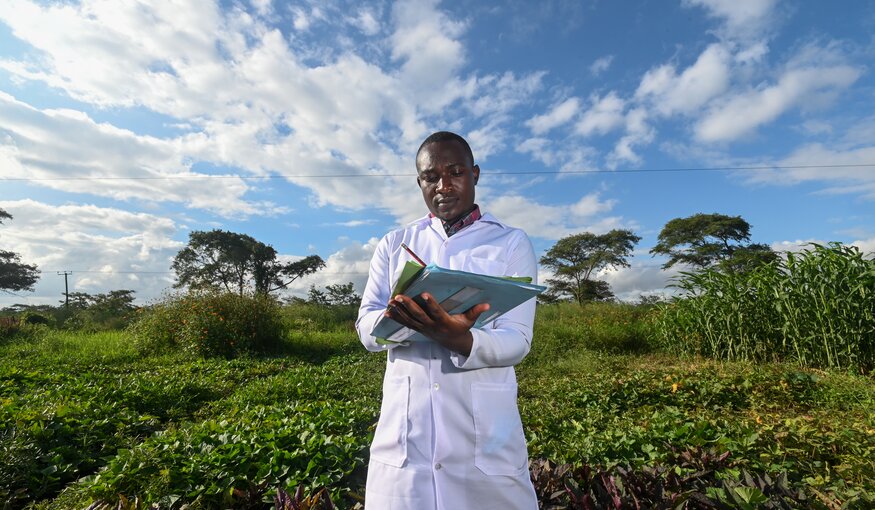In Photos: What It Takes to Operate a National Genebank
 A staff member of the National Plant Genetic Resources Centre (NPGRC) checks sweetpotato growth in the NPGRC field genebank in Lusaka, Zambia. Photo: Neil Palmer/Crop Trust.
A staff member of the National Plant Genetic Resources Centre (NPGRC) checks sweetpotato growth in the NPGRC field genebank in Lusaka, Zambia. Photo: Neil Palmer/Crop Trust.19 August 2022
The National Plant Genetic Resources Centre (NPGRC) in Zambia is one of five national genebanks in Africa the Crop Trust is working with through its Seeds for Resilience (SFR) Project. This five-year project supports national genebanks to strengthen their capacity for long-term conservation of their crop diversity collections.
National genebanks are integral to the future development of agriculture. Follow the work of genebank staff through this photo essay as they conserve staple crops, share plant samples with farmers and researchers, document data and more — all important steps in conserving crop diversity and using it to develop climate-resilient crops.
 (Photo: Neil Palmer/Crop Trust)
(Photo: Neil Palmer/Crop Trust)
Staff at work in the seed room of the National Plant Genetic Resources Centre (NPGRC) at the Central Research Station of the Zambia Agriculture Research Institute (ZARI), in Lusaka. The NPGRC’s genebank conserves germplasm of food crops from all three of the country’s agro-ecological zones.
 (Photo: Neil Palmer/Crop Trust)
(Photo: Neil Palmer/Crop Trust)
A packet of sorghum seeds retrieved from one of the freezers at the NPGRC. The genebank safeguards over 6,500 samples of locally-adapted crops and their wild relatives such as sorghum, millet, cowpea maize, sunflower, and bambara groundnut. Many of the samples offer farmers and researchers with options for adapting agriculture in the country to challenges related to climate change.
 (Photo: Neil Palmer/Crop Trust)
(Photo: Neil Palmer/Crop Trust)
Sorghum seeds germinate in a petri dish at the NPGRC. Despite the importance of its crop collections, the NPGRC has faced a number of challenges over the years. These include funding shortfalls, the need to improve its operating procedures, and the need to reach more germplasm “users” such as farmers and researchers. The SFR project, an initiative of the Crop Trust and Germany’s KfW Development Bank, is supporting the NPGRC to respond to these kinds of challenges.
 (Photo: Neil Palmer/Crop Trust)
(Photo: Neil Palmer/Crop Trust)
Zondwayo Ndhlovu, a technical research assistant at the NPGRC, studies sorghum plants grown using seeds conserved at the genebank. Taking note of a plant’s morphological details are part of the process of characterisation, a key operation to ensure samples are correctly described for germplasm users.
 (Photo: Neil Palmer/Crop Trust)
(Photo: Neil Palmer/Crop Trust)
Masiye Tembo, Documentation Officer at NPGRC, checks paper files relating to samples held at the genebank. One of the objectives of the SFR project is to digitise paper records and upload the seed information to Genesys, an online portal, where they will be accessible to genebank users globally.
 (Photo: Neil Palmer/Crop Trust)
(Photo: Neil Palmer/Crop Trust)
Graybill Munkombwe, curator of the NPGRC, addresses farmers at a Germplasm Evaluation User Group meeting in Rufunsa District, eastern Zambia. SFR aims to ensure that local farmers -as key users of germplasm- can assess and use samples from the NPGRC to improve the resilience of local food production to the challenges of climate change.
 (Photo: Neil Palmer/Crop Trust)
(Photo: Neil Palmer/Crop Trust)
Farmers at a Germplasm Evaluation User Group meeting in Rufunsa District, eastern Zambia, discuss the task of choosing their favourite crop varieties from special nurseries established under the SFR project. The project has established eight such nurseries in Zambia in order to reach hundreds of farmers, with a particular focus on women and youth.
 (Photo: Neil Palmer/Crop Trust)
(Photo: Neil Palmer/Crop Trust)
A farmer ties a ribbon around her favourite variety of sorghum growing in a SFR germplasm evaluation nursery in Chirunda, southern Zambia. Subsequent discussions of farmers’ preferences with researchers enable the NPGRC to prioritise seeds for regeneration and multiplication. Farmers preferences will also be used in the genebank’s descriptions of the samples held on international databases.
 (Photo: Neil Palmer/Crop Trust)
(Photo: Neil Palmer/Crop Trust)
Fred Rattunde, a Crop Trust consultant who is coordinating the SFR work in Africa, makes notes in one of the project’s sorghum nurseries, in Rufunsa District, Zambia. For Rattunde, SFR is “empowering the African national genebanks to share their genetic material, their national heritage”. It’s through this work that he believes “the incredible value of their collections can see the light of day and contribute to new options for farmers to meet the new challenges that are emerging.”
 (Photo: Neil Palmer/Crop Trust)
(Photo: Neil Palmer/Crop Trust)
Staff at the NPGRC outside the genebank building in Lusaka. SFR is also working with national genebanks in Nigeria, Ethiopia, Kenya and Ghana to support the long-term conservation of locally-adapted crops and encourage their use by farmers and researchers.
Categories: Seeds for Resilience, Sorghum, Food Security

